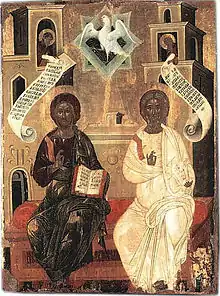Hypostasis (philosophy and religion)
Hypostasis (plural: hypostases), from the Greek ὑπόστασις (hypóstasis), is the underlying state or underlying substance and is the fundamental reality that supports all else. In Neoplatonism the hypostasis of the soul, the intellect (nous) and "the one" was addressed by Plotinus.[1] In Christian theology, the Holy Trinity consists of three hypostases: Hypostasis of the Father, Hypostasis of the Son, and Hypostasis of the Holy Spirit.[2]
| Part of a series on |
| Philosophy |
|---|
 Left to right: Plato, Kant, Nietzsche, Buddha, Confucius, Avicenna |
|
Ancient Greek philosophy
Pseudo-Aristotle used hypostasis in the sense of material substance.[3]
Neoplatonists argue that beneath the surface phenomena that present themselves to our senses are three higher spiritual principles, or hypostases, each one more sublime than the preceding. For Plotinus, these are the Soul, the Intellect, and the One.[1][4]
Christian theology

The term hypostasis has a particular significance in Christian theology, particularly in Christian Triadology (study of the Holy Trinity), and also in Christology (study of Christ).[5][6]
Hypostasis in Christian Triadology
In Christian Triadology (study of the Holy Trinity) three specific theological concepts have emerged throughout history,[7] in reference to number and mutual relations of divine hypostases:
- monohypostatic (or miahypostatic) concept advocates that God has only one hypostasis;[8][9]
- dyohypostatic concept advocates that God has two hypostases (Father and Son);[10]
- trihypostatic concept advocates that God has three hypostases (Father, Son and the Holy Spirit).[11] The great majority of Christians, including Catholics, Eastern Orthodox, Oriental Orthodox, and most Protestants, consider trihypostatic Trinitarian doctrine to be definitively Christian, and thus consider other groups which claim to be Christian but do not adhere to this doctrine as "non-Christian".
Hypostasis in Christology
Within Christology, two specific theological concepts have emerged throughout history, in reference to the Hypostasis of Christ:
History of use
In early Christian writings, hypostasis was used to denote "being" or "substantive reality" and was not always distinguished in meaning from terms like ousia ('essence'), substantia ('substance') or qnoma (specific term in Syriac Christianity).[14] It was used in this way by Tatian and Origen[7] and also in the anathemas appended to the Nicene Creed of 325.
It was mainly under the influence of the Cappadocian Fathers that the terminology was clarified and standardized so that the formula "three hypostases in one ousia" came to be accepted as an epitome of the orthodox doctrine of the Trinity.[15] The first person to propose a difference in the meanings of hypostasis and ousía, and for using hypostasis as synonym of Person, was Basil of Caesarea,[16] namely in his letters 214 (375 A.D.)[17] and 236 (376 A.D.)[18] Specifically, Basil of Caesarea argues that the two terms are not synonymous and that they, therefore, are not to be used indiscriminately in referring to the Godhead.[19] He writes:
The distinction between ousia and hypostases is the same as that between the general and the particular; as, for instance, between the animal and the particular man. Wherefore, in the case of the Godhead, we confess one essence or substance so as not to give variant definition of existence, but we confess a particular hypostasis, in order that our conception of Father, Son, and Holy Spirit may be without confusion and clear.[15]
This consensus, however, was not achieved without some confusion at first in the minds of Western theologians since in the West the vocabulary was different.[20] Many Latin-speaking theologians understood hypo-stasis as "sub-stantia" (substance); thus when speaking of three "hypostases" in the Godhead, they might suspect three "substances" or tritheism. However, from the middle of the fifth century onwards, marked by Council of Chalcedon, the word came to be contrasted with ousia and used to mean "individual reality," especially in the trinitarian and Christological contexts. The Christian concept of the Trinity is often described as being one God existing in three distinct hypostases/personae/persons.[21]
John Calvin's Continuity with Patristic Tradition
"The word ὑπόστασις which, by following others, I have rendered substance, denotes not, as I think, the being or essence of the Father, but his person; for it would be strange to say that the essence of God is impressed on Christ, as the essence of both is simply the same. But it may truly and fitly be said that whatever peculiarly belongs to the Father is exhibited in Christ, so that he who knows him knows what is in the Father. And in this sense do the orthodox fathers take this term, hypostasis, considering it to be threefold in God, while the essence (οὐσία) is simply one. Hilary everywhere takes the Latin word substance for person. But though it be not the Apostle's object in this place to speak of what Christ is in himself, but of what he is really to us, yet he sufficiently confutes the Asians and Sabellians; for he claims for Christ what belongs to God alone, and also refers to two distinct persons, as to the Father and the Son. For we hence learn that the Son is one God with the Father, and that he is yet in a sense distinct from him, so that a subsistence or person belongs to both."[22]
See also
- Haecceity – a term used by the followers of Duns Scotus to refer to that which formally distinguishes one thing from another with a common nature
- Hypokeimenon
- Hypostatic union
- Hypostatic abstraction
- Instantiation principle
- Kalyptos in Gnosticism
- Noema – a similar term used by Edmund Husserl
- Prakṛti – a similar term found in Hinduism
- Principle of individuation
- Prosopon or persona
- Reification (fallacy)
- Substance theory
References
- Anton 1977, pp. 258–271.
- The Encyclopedia of Christianity. Vol. 5. Fahlbusch, Erwin, Lochman, Jan Milič, Mbiti, John S., Pelikan, Jaroslav, 1923–2006, Vischer, Lukas, Bromiley, G. W. (Geoffrey William). Grand Rapids, Michigan: Eerdman. 2008. p. 543. ISBN 978-0802824134. OCLC 39914033.
{{cite book}}: CS1 maint: others (link) - Pseudo-Aristotle, De mundo, 4.19.
- Neoplatonism (Ancient Philosophies) by Pauliina Remes (2008), University of California Press ISBN 0520258347, pp. 48–52.
- Meyendorff 1989, pp. 190–192, 198, 257, 362.
- Daley 2009, pp. 342–345.
- Ramelli 2012, pp. 302–350.
- Lienhard 1993, pp. 97–99.
- Bulgakov 2009, pp. 82, 143–144.
- Lienhard 1993, pp. 94–97.
- Bulgakov 2009, pp. 15, 143, 147.
- McGuckin 2011, p. 57.
- Kuhn 2019.
- Meyendorff 1989, p. 173.
- González, Justo L. (1987). A History of Christian Thought: From the Beginnings to the Council of Chalcedon. Nashville, TN: Abingdon Press. p. 307. ISBN 0687171822.
- Johannes (2018-03-31). "Ousía and hypostasis from the philosophers to the councils". Ousía and hypostasis from the philosophers to the councils. Retrieved 2021-09-23.
- "St Basil the Great, LETTERS – Third Part – Full text, in English – 1". www.elpenor.org. Retrieved 2021-09-23.
- "St Basil the Great, LETTERS – Third Part – Full text, in English – 39". www.elpenor.org. Retrieved 2021-09-23.
- Turcescu 1997, pp. 374–395.
- Weedman 2007, pp. 95–97.
- González, Justo L (2005), "Hypostasis", Essential Theological Terms, Louisville: Westminster John Knox Press, pp. 80–81, ISBN 978-0664228101
- John Calvin, Commentary on Hebrews, 35 (CCEL PDF ed.); https://ccel.org/ccel/c/calvin/calcom44/cache/calcom44.pdf; plain text here: https://www.studylight.org/commentaries/eng/cal/hebrews-1.html
Sources
- Anton, John P. (1977). "Some Logical Aspects of the Concept of Hypostasis in Plotinus". The Review of Metaphysics. 31 (2): 258–271. JSTOR 20127050.
- Bulgakov, Sergius (2009). The Burning Bush: On the Orthodox Veneration of the Mother of God. Grand Rapids, MI: William B. Eerdmans Publishing. ISBN 978-0802845740.
- Daley, Brian E. (2009). "The Persons in God and the Person of Christ in Patristic Theology: An Argument for Parallel Development". God in Early Christian Thought. Leiden & Boston: Brill. pp. 323–350. ISBN 978-9004174122.
- Kuhn, Michael F. (2019). God is One: A Christian Defence of Divine Unity in the Muslim Golden Age. Carlisle: Langham Publishing. ISBN 978-1783685776.
- Lienhard, Joseph T. (1993). "The Arian Controversy: Some Categories Reconsidered". Doctrines of God and Christ in the Early Church. New York and London: Garland Publishing. pp. 87–109. ISBN 978-0815310693.
- Loon, Hans van (2009). The Dyophysite Christology of Cyril of Alexandria. Leiden & Boston: Brill. ISBN 978-9004173224.
- McGuckin, John Anthony, ed. (2011). The Encyclopedia of Eastern Orthodox Christianity. Vol. 1. Malden, MA: Wiley-Blackwell.
- McLeod, Frederick G. (2010). "Theodore of Mopsuestia's Understanding of Two Hypostaseis and Two Prosopa Coinciding in One Common Prosopon". Journal of Early Christian Studies. 18 (3): 393–424. doi:10.1353/earl.2010.0011. S2CID 170594639.
- Meyendorff, John (1983) [1974]. Byzantine Theology: Historical Trends and Doctrinal Themes (2nd revised ed.). New York: Fordham University Press. ISBN 978-0823209675.
- Meyendorff, John (1989). Imperial Unity and Christian Divisions: The Church 450–680 A.D. Crestwood, NY: St. Vladimir's Seminary Press. ISBN 978-0881410563.
- Owens, Joseph (1951). The Doctrine of Being in the Aristotelian Metaphysics: A Study in the Greek Background of Mediaeval Thought. Toronto: Pontifical Institute of Mediaeval Studies.
- Pásztori-Kupán, István (2006). Theodoret of Cyrus. London & New York: Routledge. ISBN 978-1134391769.
- Ramelli, Ilaria (2012). "Origen, Greek Philosophy, and the Birth of the Trinitarian Meaning of Hypostasis". The Harvard Theological Review. 105 (3): 302–350. doi:10.1017/S0017816012000120. JSTOR 23327679. S2CID 170203381.
- Toepel, Alexander (2014). "Zur Bedeutung der Begriffe Hypostase und Prosopon bei Babai dem Großen". Georgian Christian Thought and Its Cultural Context. Leiden & Boston: Brill. pp. 151–171. ISBN 978-9004264274.
- Turcescu, Lucian (1997). "Prosopon and Hypostasis in Basil of Caesarea's "Against Eunomius" and the Epistles". Vigiliae Christianae. 51 (4): 374–395. doi:10.2307/1583868. JSTOR 1583868.
- Weedman, Mark (2007). The Trinitarian Theology of Hilary of Poitiers. Leiden & Boston: Brill. ISBN 978-9004162242.